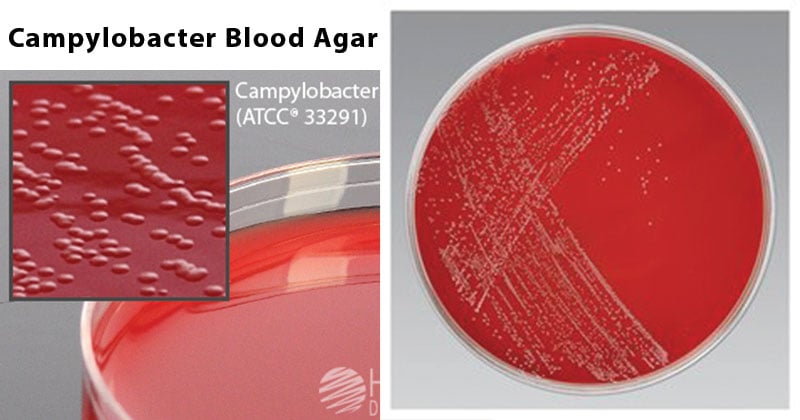Campylobacter Blood Agar (CVA) is a selective medium used for the primary isolation of Campylobacter jejuni from stool specimens. Dekeyser et al. reported the isolation of Campylobacter jejuni from the feces of patients with diarrhea and acute gastroenteritis by using a filtration technique and a selective medium with antimicrobials to suppress the normal enteric flora whereas, in 1977, Skirrow reported a selective medium containing three antimicrobics for the isolation. In 1978, Blaser et al reported success in the isolation of C. jejuni using a selective medium containing four antimicrobials (amphotericin, vancomycin, polymyxin B, and trimethoprim). Similarly, Reller et al in 1983 introduced an improved selective medium containing cefoperazone, Vancomycin, and amphotericin B for the isolation of C. jejuni. They reported that this combination of antimicrobials provided better suppression of normal fecal flora thereby allowing better isolation of C. jejuni from the fecal specimen.

Interesting Science Videos
Composition of Campylobacter Blood Agar (CVA)
| Ingredients | Gm/Liter |
| Agar | 15.0gm |
| Trimethoprim | 5.0mg |
| Casein peptone | 15.0gm |
| Meat peptone | 5.0gm |
| Sodium Chloride | 5.0gm |
| Yeast Extract | 2.0gm |
| Dextrose | 1.0gm |
| Vancomycin | 10.0mg |
| Amphotericin B | 0.2mg |
| Polymyxin B | 2500 U |
| Sodium Bisulfite | 0.1gm |
| Cephalothin | 15.0mg |
| Sheep Blood | 100ml |
| Demineralized water | 1000.0 ml |
Final pH 7.0 +/- 0.2 at 25ºC.
Principle of Campylobacter Blood Agar (CVA)
The medium contains a variety of peptones and extracts that supplies all the necessary growth factors including nitrogen compounds, carbon, sulfur, and trace ingredients for recovery of Campylobacter species. Yeast extract is a source of B vitamins while dextrose is utilized as an energy source. Sheep blood provides hemin and supplies other necessary additional growth factors. The incorporation of antimicrobial agents, cephalothin, polymyxin B, trimethoprim, amphotericin B, and vancomycin, suppress the growth of the normal microbial flora in fecal specimens, thereby facilitating isolation of C. jejuni. Vancomycin is a glycopeptide that inhibits many species of gram-positive bacteria and polymyxin B inhibits most gram-negative bacilli except for Proteus. Trimethoprim is inhibitory for Proteus spp. Amphotericin B is an antifungal agent that can inhibit a wide variety of yeasts and molds. Agar is the solidifying agent. Campylobacter jejuni are thermophiles, therefore, inoculated plates should be incubated at 42°C to accelerate growth; the higher temperature also helps to inhibit any background flora that may be present.
Preparation of Campylobacter Blood Agar (CVA)
- Preparation of antibiotic supplement
- Add components to 10.0ml of distilled water and filter sterilize.
- Preparation of medium
- Add components, except sheep blood and antibiotic solution, to distilled water and bring the volume to 890.0ml and mix thoroughly.
- Gently heat and bring to boiling.
- Autoclave for 15 min at 15 lbs pressure at 121°C.
- Cool at 45°C-50°C. Aseptically add 100.0ml of sterile sheep blood and 10.0ml of sterile antibiotic solution.
- Mix thoroughly and pour into sterile Petri dishes or distribute into sterile tubes.
Results Interpretation on Campylobacter Blood Agar (CVA)
- Campylobacter jejuni typically appears as small, grayish in coloration, flat with irregular edges, non-hemolytic, mucoid colonies at 24 and 48 hours.
- A full 48-hour incubation is required as some isolates may be barely visible after only 24 hours of incubation.
- Some colonies may appear as round colonies 1-2mm in diameter that are convex, entire and glistening.
- Spreading and swarming are common for isolates from fresh clinical specimens.
Uses of Campylobacter Blood Agar (CVA)
- It is an enriched selective blood agar that will support good growth of Campylobacter jejuni and used for the primary isolation and cultivation of Campylobacter jejuni from fecal, food and environmental specimens.
Limitations of Campylobacter Blood Agar (CVA)
- It is recommended that biochemical, immunological, molecular, or mass spectrometry testing be performed on colonies from pure culture for complete identification.
- C. jejuni is thermophilic so it is important to incubate the plates at 42ºC to accelerate growth; the higher temperature also helps to inhibit any background flora that may be present. If incubated at lower temperatures growth may be delayed and the selectivity of the medium is reduced.
- Some Campylobacter isolates produce weakly positive oxidase reactions when grown on Campylobacter Blood Agar due to dextrose in the medium. Subculturing such isolates in the medium without the dextrose and repetition of the oxidase test is recommended.
- Campylobacter fetus, Campylobacter lari, Campylobacter hyointestinalis, and Campylobacter upsaliensis are inhibited by cephalothin.
References
- Dalynn Biologicals
- Hardy Diagnostic
- Thermo fisher
- Himedia
- Ronald M. Atlas and James W. Snyder (2014). Handbook of media for clinical and public health microbiology. CRC Press. Taylor & Francis Group, LLC. Page no.94-95
